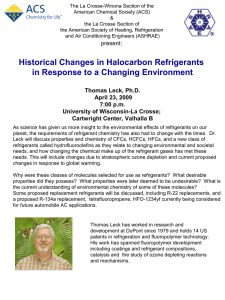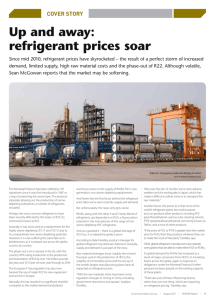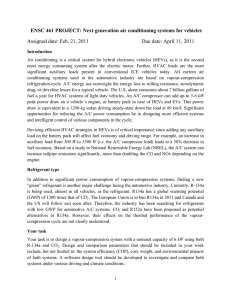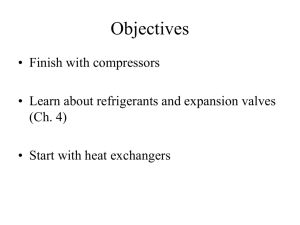IRJET- Performance Analysis of R-134a with ECO Friendly Refrigerant in Vapour Compression Refrigeration Cycle
advertisement
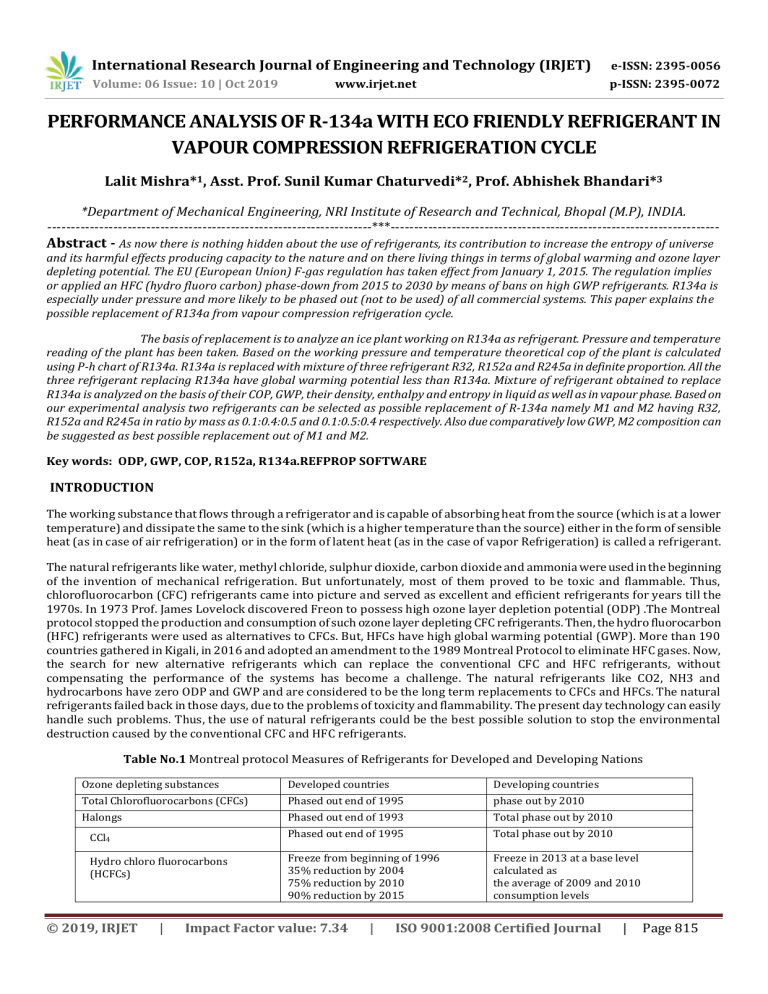
International Research Journal of Engineering and Technology (IRJET) e-ISSN: 2395-0056 Volume: 06 Issue: 10 | Oct 2019 p-ISSN: 2395-0072 www.irjet.net PERFORMANCE ANALYSIS OF R-134a WITH ECO FRIENDLY REFRIGERANT IN VAPOUR COMPRESSION REFRIGERATION CYCLE Lalit Mishra*1, Asst. Prof. Sunil Kumar Chaturvedi*2, Prof. Abhishek Bhandari*3 *Department of Mechanical Engineering, NRI Institute of Research and Technical, Bhopal (M.P), INDIA. ---------------------------------------------------------------------***---------------------------------------------------------------------- Abstract - As now there is nothing hidden about the use of refrigerants, its contribution to increase the entropy of universe and its harmful effects producing capacity to the nature and on there living things in terms of global warming and ozone layer depleting potential. The EU (European Union) F-gas regulation has taken effect from January 1, 2015. The regulation implies or applied an HFC (hydro fluoro carbon) phase-down from 2015 to 2030 by means of bans on high GWP refrigerants. R134a is especially under pressure and more likely to be phased out (not to be used) of all commercial systems. This paper explains the possible replacement of R134a from vapour compression refrigeration cycle. The basis of replacement is to analyze an ice plant working on R134a as refrigerant. Pressure and temperature reading of the plant has been taken. Based on the working pressure and temperature theoretical cop of the plant is calculated using P-h chart of R134a. R134a is replaced with mixture of three refrigerant R32, R152a and R245a in definite proportion. All the three refrigerant replacing R134a have global warming potential less than R134a. Mixture of refrigerant obtained to replace R134a is analyzed on the basis of their COP, GWP, their density, enthalpy and entropy in liquid as well as in vapour phase. Based on our experimental analysis two refrigerants can be selected as possible replacement of R-134a namely M1 and M2 having R32, R152a and R245a in ratio by mass as 0.1:0.4:0.5 and 0.1:0.5:0.4 respectively. Also due comparatively low GWP, M2 composition can be suggested as best possible replacement out of M1 and M2. Key words: ODP, GWP, COP, R152a, R134a.REFPROP SOFTWARE INTRODUCTION The working substance that flows through a refrigerator and is capable of absorbing heat from the source (which is at a lower temperature) and dissipate the same to the sink (which is a higher temperature than the source) either in the form of sensible heat (as in case of air refrigeration) or in the form of latent heat (as in the case of vapor Refrigeration) is called a refrigerant. The natural refrigerants like water, methyl chloride, sulphur dioxide, carbon dioxide and ammonia were used in the beginning of the invention of mechanical refrigeration. But unfortunately, most of them proved to be toxic and flammable. Thus, chlorofluorocarbon (CFC) refrigerants came into picture and served as excellent and efficient refrigerants for years till the 1970s. In 1973 Prof. James Lovelock discovered Freon to possess high ozone layer depletion potential (ODP) .The Montreal protocol stopped the production and consumption of such ozone layer depleting CFC refrigerants. Then, the hydro fluorocarbon (HFC) refrigerants were used as alternatives to CFCs. But, HFCs have high global warming potential (GWP). More than 190 countries gathered in Kigali, in 2016 and adopted an amendment to the 1989 Montreal Protocol to eliminate HFC gases. Now, the search for new alternative refrigerants which can replace the conventional CFC and HFC refrigerants, without compensating the performance of the systems has become a challenge. The natural refrigerants like CO2, NH3 and hydrocarbons have zero ODP and GWP and are considered to be the long term replacements to CFCs and HFCs. The natural refrigerants failed back in those days, due to the problems of toxicity and flammability. The present day technology can easily handle such problems. Thus, the use of natural refrigerants could be the best possible solution to stop the environmental destruction caused by the conventional CFC and HFC refrigerants. Table No.1 Montreal protocol Measures of Refrigerants for Developed and Developing Nations Ozone depleting substances Developed countries Developing countries Total Chlorofluorocarbons (CFCs) Phased out end of 1995 phase out by 2010 Halongs Phased out end of 1993 Total phase out by 2010 CCl4 Phased out end of 1995 Total phase out by 2010 Hydro chloro fluorocarbons (HCFCs) Freeze from beginning of 1996 35% reduction by 2004 75% reduction by 2010 90% reduction by 2015 Freeze in 2013 at a base level calculated as the average of 2009 and 2010 consumption levels © 2019, IRJET | Impact Factor value: 7.34 | ISO 9001:2008 Certified Journal | Page 815 International Research Journal of Engineering and Technology (IRJET) e-ISSN: 2395-0056 Volume: 06 Issue: 10 | Oct 2019 p-ISSN: 2395-0072 www.irjet.net Total phase out by 2020 10% reduction by 2015 35% reduction by 2020 67.5% reduction by 2025 Total phase out by 2030 Hydro bromo fluorocarbons (HBFCs) Phased out end of 1995 Phased out end of 1995 Methyl bromide (CH3Br) (horticultural uses) Freeze in 1995 at 1991 base level 25% reduction by 1999 50% reduction by 2001 70% reduction by 2003 Total phase out by 2005 Freeze in 2002 at average 1995-1998 base level 20% reduction by 2005 Total phase out by 2015 Bromo chloro methane (CH2BrCl) Phase out by 2002 Phase out by 2002 A working fluid in a compression refrigeration system must satisfy a number of requirements that can be divided into two groups: 1. The refrigerant should not cause any risk of injuries, fire or property damage in case of leakage. 2. The chemical, physical and thermodynamic properties of the refrigerant must suit the system and the working conditions at a reasonable cost. LITERATURE REVIEW R. Cabello, E. Torrella and J. Navarro-Esbri [1], have analyzed the performance of a vapour compression refrigeration system using three different working fluids (R134a, R407c and R22). The operating variables are the evaporating pressure, condensing pressure and degree of superheating at the compressor inlet. They analyzed that the power consumption decreases when compression ratio increases with R22 than using the other working fluids. B.O. Bolaji et al [2] investigated experimentally the performances of three ozone friendly Hydrofluorocarbon (HFC) refrigerants R12, R152a and R134a. R152a refrigerant found as a drop in replacement for R134a in vapour compression system. B.O. Bolaji [3] discussed the process of selecting environmental-friendly refrigerants that have zero ozone depletion potential and low global warming potential. R23 and R32 from methane derivatives and R152a, R143a, R134a and R125 from ethane derivatives are the emerging refrigerants that are nontoxic, have low flammability and environmental-friendly. These refrigerants need theoretical and experimental analysis to investigate their performance in the system. James M. Calm [4], has studied the emission and environmental impacts of R11, R123, R-134a due to leakage from centrifugal chiller system. He also investigated the total impact in form of TEWI and change in system efficiency or performance due to charge loss. He also summarized the methods to reduce the refrigerant losses by the system like design modifications, improvement in preventive maintenance techniques, use of purge system for refrigerant vapour recovery, servicing and lubricant changing in system. Samira Benhadid-Dib and Ahmed Benzaoui [5], have showed that the uses of halogenated refrigerants are harmful for environment and the use of "natural" refrigerants become a possible solution. Here natural refrigerants are used as an alternative solution to replace halogenated refrigerants. The solution to the environmental impacts of refrigerant gases by a gas which contains no chlorine no fluorine and does not reject any CO2 emissions in the atmosphere. The researchers showed that emissions have bad effects on our environment. They also concerned by a contribution to the reduction of greenhouse gases and by the replacement of the polluting cooling fluids (HCFC). Eric Granryd [6], has enlisted the different hydrocarbons as working medium in refrigeration system. He studied the different safety standards related to these refrigerants. He showed the properties of hydrocarbons (i.e. no ODP and negligible GWP) that make them interesting refrigerating alternatives for energy efficient and environmentally friendly. But safety precautions due to flammability must be seriously taken into account. Y. S. Lee and C. C. Su [7], have studied the performance of VCRS with isobutene and compare the results with R12 and R22. They used R600a about 150 g and set the refrigeration temperature about 4 °C and -10 °C to maintain the situation of cold storage and freezing applications. They used 0.7 mm internal diameter and 4 to 4.5 m length of capillary tube for cold storage applications and 0.6 mm internal diameter and 4.5 to 5 m length of capillary tube for freezing applications. They observed that © 2019, IRJET | Impact Factor value: 7.34 | ISO 9001:2008 Certified Journal | Page 816 International Research Journal of Engineering and Technology (IRJET) e-ISSN: 2395-0056 Volume: 06 Issue: 10 | Oct 2019 p-ISSN: 2395-0072 www.irjet.net the COP lies between 1.2 and 4.5 in cold storage applications and between 0.8 and 3.5 in freezing applications. They also observed that the system with two capillary tubes in parallel performs better in the cold storage and air conditioning applications, whereas that with a single tube is suitable in the freezing applications. Mao-Gang He, Tie-Chen Li, Zhi-Gang Liu and Ying Zhang [8], have analyzed that the R152a/R125 mixture in the composition of 0.85 mass fraction of R152a has a similar refrigeration performance with the existing refrigerant R12.Experimental research on the main refrigeration performances of domestic refrigerators was conducted, under the different proportions and charge amounts, when R152a/R125 is used to substitute R12 as a drop-in refrigerant. The experimental results indicate that R152a/R125 can be used to replace R12 as a new generation refrigerant of domestic refrigerators, because of its well environmentally acceptable properties and its favorable refrigeration performances. Ki-Jung Park, Taebeom Seo and Dongsoo Jung [9], have analyzed performances of two pure hydrocarbons and seven mixtures composed of propylene, propane, R152a, and di methylether were measured to substitute for R22 in residential airconditioners and heat pumps at the evaporation and condensation temperatures of 7 °C and 45 °C, respectively. Test results show that the coefficient of performance of these mixtures is up to 5.7% higher than that of R22. Whereas propane showed 11.5% reduction in capacity, most of the fluids had a similar capacity to that of R22. For these fluids, compressor-discharge temperatures were reduced by 11–17 °C. For all fluids tested, the amount of charge was reduced by up to 55% as compared to R22. Overall, these fluids provide good performances with reasonable energy savings without any environmental problem and thus can be used as long-term alternatives for residential air-conditioning and heat-pumping applications. A. Baskaran, and P. Koshy Mathews [10], a performance analysis on a vapour compression refrigeration system with various eco-friendly refrigerants of HFC152a, HFC32, HC290, HC1270, HC600a and RE170 were done and their results were compared with R134a as possible alternative replacement. The results showed that the alternative refrigerants investigated in the analysis RE170, R152a and R600a have a slightly higher performance coefficient (COP) than R134a for the condensation temperature of 50:C and evaporating temperatures ranging between -30:C and 10:C.Refrigerant RE170 instead of R134a was found to be a replacement refrigerant among other alternatives. K. Mani and V. Selladurai [11], have analyzed a vapour compression refrigeration system with the new R290/R600a refrigerant mixture as drop-in replacement was conducted and compared with R12 and R134a. The VCRS was initially designed to operate with R12.The results showed that the refrigerant R134a showed slightly lower COP than R12. The discharge temperature and discharge pressure of the R290/R600a mixture was very close to R12. The R290/R600a (68/32 by wt %) mixture can be considered as a drop-in replacement refrigerant for R12 and R134a. A.S. Dalkilic and S. Wongwises [12], have studied the performance on a VCRS with refrigerant mixtures based on R134a, R152a, R32, R290, R1270, R600 and R600a was done for various ratios and their results are compared with R12, R22 and R134a as possible alternative replacements. The results showed that all of the alternative refrigerants investigated in the analysis have a slightly lower COP than R12, R22, and R134a for the condensation temperature of 50 °C and evaporating temperatures ranging between −30 °C and 10 °C. Refrigerant blends of R290/R600a (40/60 by wt. %) instead of R12 and R290/R1270 (20/80 by wt. %) instead of R22 are found to be replacement refrigerants among other alternatives. Vincenzo La Rocca and Giuseppe Panno [13], have analyzed and compared the performance of a vapour compression refrigerating unit operating with R22, and with three new HFC fluids, substituting the former according to Regulation No 2037/2000. Here the plant working efficiency was first tested with R22 and then with three new HFC fluids: R417a, R422a and R422d. It is analyzed that the performance with the new tested fluids did not result as efficient as when using R22. Vincenzo La Rocca and Giuseppe Panno [14], have analyzed and compared the performance of a vapour compression refrigerating unit operating with R22, and with three new HFC fluids, substituting the former according to Regulation No 2037/2000. Here the plant working efficiency was first tested with R22 and then with three new HFC fluids: R417a, R422a and R422d. It is analyzed that the performance with the new tested fluids did not result as efficient as when using R22. Minxia Li, Chaobin Dang and Eiji Hihara [15], have investigated that Hfo1234yf has been proposed for mobile airconditioners due to its low GWP and performance comparable to that of R134a. However, its performance is inferior to that of R410a. This makes it difficult to be applied to residential air-conditioners. In order to apply the low GWP refrigerant to residential air-conditioners, refrigerant mixtures of Hfo1234yf and R32 are proposed, and their flow boiling heat transfer performances were investigated at two mass fractions (80/20 and 50/50 by mass %) in a smooth horizontal tube with an inner diameter of 2 mm. The results showed that the heat transfer coefficients of the mixture with an R32 mass fraction of 20% were 10–30% less than those of pure Hfo1234yf for various mass and heat fluxes. When the mass fraction of R32 increased to 50%, © 2019, IRJET | Impact Factor value: 7.34 | ISO 9001:2008 Certified Journal | Page 817 International Research Journal of Engineering and Technology (IRJET) e-ISSN: 2395-0056 Volume: 06 Issue: 10 | Oct 2019 p-ISSN: 2395-0072 www.irjet.net the heat transfer coefficients of the mixture were 10–20% greater than those of pure Hfo1234yf under conditions of large mass and heat fluxes. RESEARCH OBJECTIVES The aim of this study is to provide a detailed insight into the characteristics of robust mechanism for preparing a new ecofriendly mixture of refrigerant as a replacement of R-134A. We proposed a new scheme which applies hybrid approach using different highly eco-friendly refrigerant mixture. The scheme is robust against existing methodology using other alternative refrigerant To Analyse and show its thermodynamic performance at certain working parameters on these highly eco-friendly refrigerant mixture for vapour compression refrigeration system. To compare the proposed scheme with the existing scheme in different aspects and discuss the advantages and the disadvantages of our scheme. To calculate the GWP, COP To cultivates an idea of use of highly eco-friendly refrigerant mixture in place of R-134a refrigerant which applying a hybrid approach to the proposed scheme. Its advantages are clear and significant. METHODOLOGY The serious nature problem like increase in entropy of universe, global warming, ozone depletion as mentioned in above introduction and found from literature survey an international commetie was constructed for both developing and developed contries which given the certain measures for the use of refrigerants in domestic, commercial and industrial purpose. The following are the main components of ice plants and their specifications are shown in fig.1and table 1 below respectively. Figure 1 Block diagram of ice plant COMPONENTS OF AN ICE PLANT: 1) 2) 3) 4) 5) 6) COMPRESSOR CONDENSOR RECEIVERS FILTER DRIER EXPANSION DEVICES EVAPORATOR © 2019, IRJET | Impact Factor value: 7.34 | ISO 9001:2008 Certified Journal | Page 818 International Research Journal of Engineering and Technology (IRJET) e-ISSN: 2395-0056 Volume: 06 Issue: 10 | Oct 2019 p-ISSN: 2395-0072 www.irjet.net 7) CHILLING TANK 8) REFRIGERANT ACCUMULATOR 9) PRESSURE GAUGE Table No.2 Components specification Components Specifications Specifications of the compressor used in project are given below: Application with R-134a Type -Hermetically sealed compressor Compressor Electrical circuit-CSIR Operating voltage- 1ph, 180-260V AC Start capacitor- 40-60 microF,@275V A Capacity- 240BTU Condenser Single role forced air cool Condenser with fan. Working pressure = 500psig (34.01bar) Filter drier For use with CFC, HCFC, HFC, R-134a, R12, R22, R40, R401a, R402a, R404a, R407a, R502a, R502a Refrigerants Type- capillary tube Expansion device Diameter of capillary tube is 1.0 mm. Length of capillary tube is 2.5m Specifications of the evaporator used in project are given below: Evaporator coil Diameter of copper coil is 0.6mm. Length of copper coil is 7500mm. dimensions of tank – length=600mm, width=450mm, height=300mm Insulation is done with the help of wood and thermo-col. Chilling tank The thickness of wood and thermo-col are 10mm and 24.5mm Static watt hour meter Energy meter 3 Phase 4 wire energy meter Rating- 10-40 Amp, 240V, 50Hz PERFORMANCE COMPARISION OF R134a WITH ALTERNATE REFRIGERANT:R134a has high global warming potential around 1300 as mentioned in abstract hence it needs to be phased out. The basis of replacement is to analyze the performance of existing plant working on R134a and comparing it with eco friendly refrigerant which can be possible replacement of R134a. Reading of pressure and temperature for the calculation is taken from an ice plant with vapour compression refrigeration cycle using R134a.Calculation of theoretical C.O.P is by using pressure enthalpy chart or by using REFPROP SOFTWARE at pressure and temperature condition obtained from reading. Given table shows the list of refrigerant with their ozone depleting potential, global warming potential and chemical properties. It can be seen from the table that R32, R152a and R245a has GWP less than R134a, hence these three can be taken as possible replacement of R134a. Table No.3 Hydrofluorocarbons Refrigerant Properties © 2019, IRJET Refrigerants O.D.P G.W.P Chemical properties R23 0 14800 Slightly flammable | R32 0 650 Slightly flammable R125 0 3400 Not flammable R134a 0 1430 Flammable R143 0 4300 Slightly flammable R152a 0 120 Slightly flammable Impact Factor value: 7.34 | ISO 9001:2008 Certified Journal | Page 819 International Research Journal of Engineering and Technology (IRJET) e-ISSN: 2395-0056 Volume: 06 Issue: 10 | Oct 2019 p-ISSN: 2395-0072 www.irjet.net R218 0 8830 Non flammable R245a 0 950 Non Flammable These refrigerants are taken in different ratio by mass. COP, GWP and molecular of these mixture are calculated using REFPROP software. Below table’s shows refrigerants with their respective composition by mass, also it shows their respective COP, GWP and Mol.wt. Table No.4 Refrigerant Properties Refrigerants Mol. Wt Critical temp (°C) GWP ODP R134a 102 101.06 1300 0 R32 52.02 78.11 650 0 R152a 66.05 113.26 120 0 R245a 135 174.42 950 0 Table No. 5 keeping the composition of R245a constant R32 R152a R245a Cop Mol. Wt GWP 0.1 0.4 0.5 6.84 98.6 588 0.2 0.3 0.5 4.9 97.2 641 0.3 0.2 0.5 3.8 95.8 694 0.4 0.1 0.5 2.98 94.4 747 Table No.6 keeping the composition of R152a constant R32 R152a R245a Cop Mol. Wt GWP 0.1 0.5 0.4 6.84 91.8 505 0.2 0.5 0.3 4.18 83.6 475 0.3 0.5 0.2 2 75.4 445 0.4 0.5 0.1 0.71 67.2 415 Table No.7 keeping the composition of R32 constant R32 R152a R245a Cop Mol. Wt GWP 0.5 0.1 0.4 1.97 86.2 717 0.5 0.2 0.3 1.38 79.4 634 0.5 0.3 0.2 0.7 72.6 551 0.5 0.4 0.1 0.7 65.8 468 From the above table it can be concluded that composition R32/R152a/R245a 0.1:0.4:0.5 by mass from table1 and R32/R152a/R245a 0.1:0.5:0.4 by mass from table can be taken as possible replacement of R134a in vapour compression refrigeration cycle. Below table shows the composition and have been named as M1 and M2 respectively. Performance of M1 and M2 with R134a is analyzed on the basis of their density, enthalpy, entropy, molecular weight and global warming potential. Table No.8 Refrigerant taken from the tables as possible replacement Refrigerant R32 R152a R245a Mol wt GWP M1 0.1 0.4 0.5 98.6 588 M2 0.1 0.5 0.4 91.8 505 The given figures below shows the comparision analysis and variations of R134a refrigerants with mixed refrigerants at operating plant conditions © 2019, IRJET | Impact Factor value: 7.34 | ISO 9001:2008 Certified Journal | Page 820 International Research Journal of Engineering and Technology (IRJET) e-ISSN: 2395-0056 Volume: 06 Issue: 10 | Oct 2019 p-ISSN: 2395-0072 www.irjet.net (a)Variation of density with temp keeping pressure constant Figure 2 Graph liquid density vs temperature Figure 3 Graph vapour density vs temperature (b) Variation of enthalpy with temperature maintaining pressure constant Figure 4 Graph show the variation in enthalpy with keeping constant temperature © 2019, IRJET | Impact Factor value: 7.34 | ISO 9001:2008 Certified Journal | Page 821 International Research Journal of Engineering and Technology (IRJET) e-ISSN: 2395-0056 Volume: 06 Issue: 10 | Oct 2019 p-ISSN: 2395-0072 www.irjet.net (c) Variation of entropy with temperature keeping pressure constant Figure 5 Graph show the variation in entropy with keeping constant temperature (d) Global warming potential comparision Figure 6 Global warming potential(GWP) (e) Molecular Weight Figure 7 shows the molecular weight of mixture refrigerants RESULTS DISCUSSSION Table shows of R-134a comparisons with their possible replacement M1and M2 over its COP, molecular weight, global warming potential and ozone depleting potential. R134a can be replaced with M1 and M2 since both M1 and M2 has higher cop than R134a also global warming potential le less in both M1 and M2 as compared to R134a.it can also be seen that refrigerant has zero ODP. There is not much variation in molecular weight of M1 and M2 as compared to R134a. So it can be compatible in same compressor. © 2019, IRJET | Impact Factor value: 7.34 | ISO 9001:2008 Certified Journal | Page 822 International Research Journal of Engineering and Technology (IRJET) e-ISSN: 2395-0056 Volume: 06 Issue: 10 | Oct 2019 p-ISSN: 2395-0072 www.irjet.net Table 9 Result comparision of R134a with Mix 1 and Mix 2 REFRIGERENT R134a M1 M2 C.O.P 5.86 6.84 6.84 Molecular weight 102 98.6 91.8 Global warming potential 1300 588 505 Ozone depleting potential 0 0 0 CONCLUSIONS In this paper, thermodynamic analysis have been carried out on a vapor compression system using R134a as a drop-in replacement for HFC mixture M1 & M2 has been introduced and obtaining a wide range of working conditions set of steady state results have been observed. The results have been achieved varying the condensing temperature, evaporating temperature & use of IHX. The energetic comparison is performed on the basis of the mass flow rate, the compressor power consumption, and the COP. The main conclusions of this paper can be summarized as follows. Out of the two possible replacements M1 and M2, M2 can be taken as better replacement. Both M1 and M2 has same COP but global warming potential is less for M2. Also it has high enthalpy at both liquid and vapour stage so it has higher heat extracting and releasing capacity at evaporator and condenser respectively. Also the replacement M1 and M2 are halocarbon with which is nontoxic and nonflammable. Hence M2 can be suggested as best replacement. FUTURE SCOPE Keeping in mind the present scenario of climatic change and demand comfort of modern human age the researcher and inventors must have to be take a steps on all possible ways to protect/prevent or save the earth and its environment in terms of global warming effect. Refrigerants are one of the reasons which contribute the change in temperature by exchanging heat to the environment so our efforts should also be focused on the use of possible natural refrigerants replacements at lesser cost and at low potential effect on environment. REFERENCES 1) R. Cabello, E. Torrella, J. Navarro-Esbri, Experimental evaluation of a vapour compression plant performance using R134a, RR407C and R22 as working fluids, Applied Therma Engineering 24 (2004) 1905-1917. 2) B.O.Bolaji, M.A. Akintunde, T.O. Falade, Comparative analysis of performance of three ozone-friends HFC refrigerants in a vapour compression refrigerator, Journal of Sustainable Energy and Environment 2 (2011) 61-64. 3) B.O.Bolaji, Selection of environment-friendly refrigerants and the current alternatives in vapour compression refrigeration systems, Journal of Science and Management, Vol 1, No. 1 (2011) 22-26. 4) James M. Calm, ―Emissions and environmental impacts from airconditioning and refrigeration systems,‖ International Journal of Refrigeration 25, pp. 293–305, 2002. 5) Samira Benhadid-Dib, and Ahmed Benzaoui, ―Refrigerants and their impact in the environment. Use of the solar energy as the source of energy,‖ Energy Procedia 6, pp. 347–352, 2011. 6) Samira Benhadid-Dib, and Ahmed Benzaoui, ―Refrigerants and their environmental impact Substitution of hydro chlorofluorocarbon HCFC and HFC hydro fluorocarbon. Search for an adequate refrigerant,‖ Energy Procedia 18, pp. 807 – 816, 2012. 7) Eric Granryd, ―Hydrocarbons as refrigerants - an overview,‖ International Journal of Refrigeration 24, pp. 15-24, 2001. 8) Y.S. Lee, and C.C. Su, ―Experimental studies of isobutene (R600a) as the refrigerant in domestic refrigeration system,‖ Applied Thermal Engineering 22, pp. 507–519, 2002. 9) Mao-Gang He, Tie-Chen Li, Zhi-Gang Liu, and Ying Zhang, ―Testing of the mixing refrigerants HFC152a/HFC125 in domestic refrigerator,‖ Applied Thermal Engineering 25, pp. 1169–1181, 2005. 10) A.Baskaran, P.Koshy Mathews, International Journal of Scientific and Research Publications, Volume 2, Issue 9, September 2012 ISSN 2250-3153 11) Ki-Jung Park, and Dongsoo Jung, ―Thermodynamic performance of HCFC22 alternative refrigerants for residential airconditioning applications,‖ Energy and Buildings 39, pp. 675–680, 2007. © 2019, IRJET | Impact Factor value: 7.34 | ISO 9001:2008 Certified Journal | Page 823 International Research Journal of Engineering and Technology (IRJET) e-ISSN: 2395-0056 Volume: 06 Issue: 10 | Oct 2019 p-ISSN: 2395-0072 www.irjet.net 12) K. Mani, and V. Selladurai, ―Experimental analysis of a new refrigerant mixture as drop-in replacement for CFC12 and HFC134a,‖ International Journal of Thermal Sciences 47, pp. 1490– 1495, 2008. 13) A.S. Dalkilic, and S. Wong wises, ―A performance comparison of vapour-compression refrigeration system using various alternative refrigerants,‖ International Communications in Heat and Mass Transfer 37, pp. 1340–1349, 2010. 14) Vincenzo La Rocca, and Giuseppe Panno, ―Experimental performance evaluation of a vapour compression refrigerating plant when replacing R22 with alternative refrigerants, Applied Energy 88, pp. 2809–2815, 2011. 15) Minxia Li, Chaobin Dang, and Eiji Hihara, ―Flow boiling heat transfer of HFO1234yf and R32 refrigerant mixtures in a smooth horizontal tube: Part I. Experimental investigation, International Journal of Heat and Mass Transfer 55, pp. 3437– 3446, 2012. 16) A. S. Dhunde1, K. N. Wagh2, P. W. Bedarkar3. - Experimental Study of Modified Refrigerator Cum Air Conditioning and Water Cooler System. 2016 IJSRSET | Volume 2 | Issue 4 | Print ISSN : 2395-1990 | Online ISSN : 2394-4099 17) Jignesh Gohel a , Dr. Ragesh Kapadia b. Thermodynamic cycle analysis of Mobile Air Conditioning system using HFO-1234yf as an alternative replacement of HFC-134a. International Journal of Science, Engineering and Technology Research (IJSETR), Volume 5, Issue 1, January 2016 © 2019, IRJET | Impact Factor value: 7.34 | ISO 9001:2008 Certified Journal | Page 824

